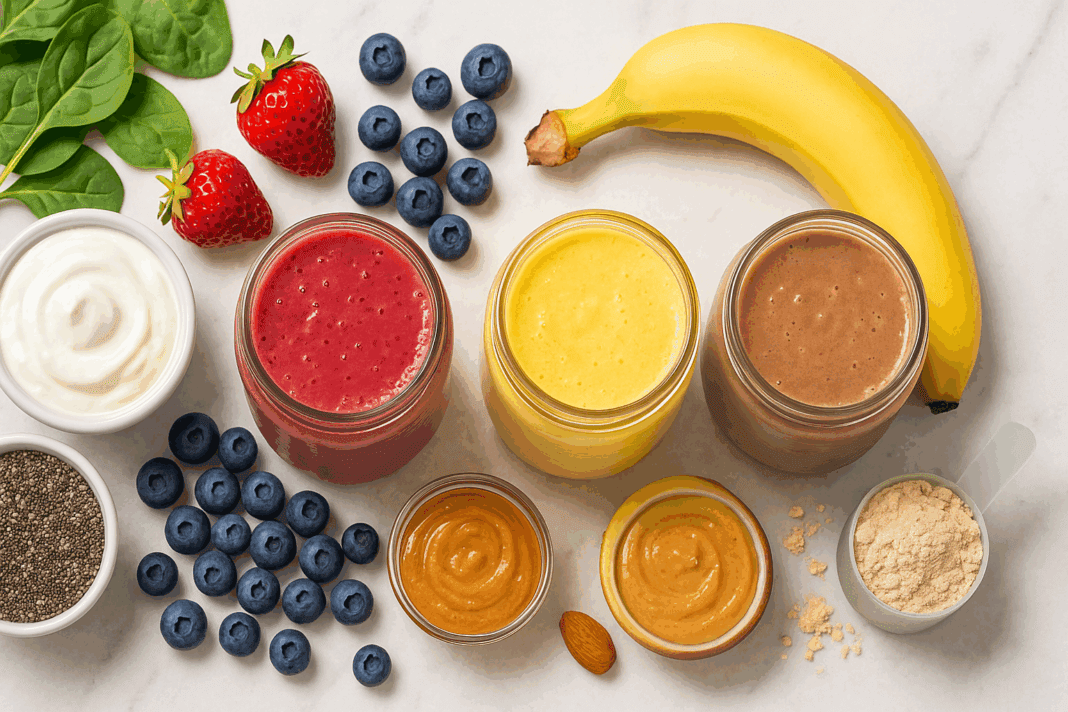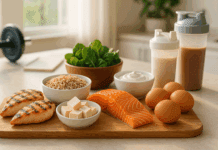In the realm of nutrition and dietary wellness, healthy smoothies have carved a niche as one of the most effective and enjoyable ways to boost daily protein intake. These nutrient-packed beverages are not only convenient and versatile but also offer an efficient route to meeting your body’s energy, muscle-building, and satiety needs. Whether you are an athlete striving for performance, a busy professional looking for meal replacements, or someone on a journey toward improved wellness, integrating healthy smoothies into your routine can yield tremendous benefits. The beauty of a high-protein smoothie lies in its capacity to deliver complete nutrition in a single glass, often combining protein with fiber, healthy fats, antioxidants, and essential micronutrients.
You may also like : The Ultimate High-Protein Nutrition Plan: How to Gain Muscle in Women Safely and Effectively
What sets healthy smoothies apart from standard shakes or snack options is their adaptability. With the right ingredients, they can support muscle repair after workouts, help regulate blood sugar levels, and keep hunger at bay for hours. Unlike processed snack bars or sugary beverages, smoothies can be crafted to reflect your specific dietary goals. From dairy-based options to vegan-friendly blends using plant protein sources, the possibilities are endless. Moreover, the inclusion of fruits, vegetables, seeds, and nuts adds not only flavor and texture but also a burst of phytonutrients that support immune function and metabolic health.
For those adhering to high-protein diets, especially under categories like B1. High-Protein Diets and B. Nutrition & Diet, smoothies offer a seamless and delicious way to achieve macronutrient targets. They can serve as a full meal or a nutrient-dense snack depending on their composition. Additionally, they provide a highly digestible form of nutrition that is ideal for individuals with gastrointestinal sensitivities or those seeking a lighter alternative to solid meals. Ultimately, high-protein smoothies encapsulate the principles of smart nutrition: efficiency, satisfaction, and optimal nourishment.
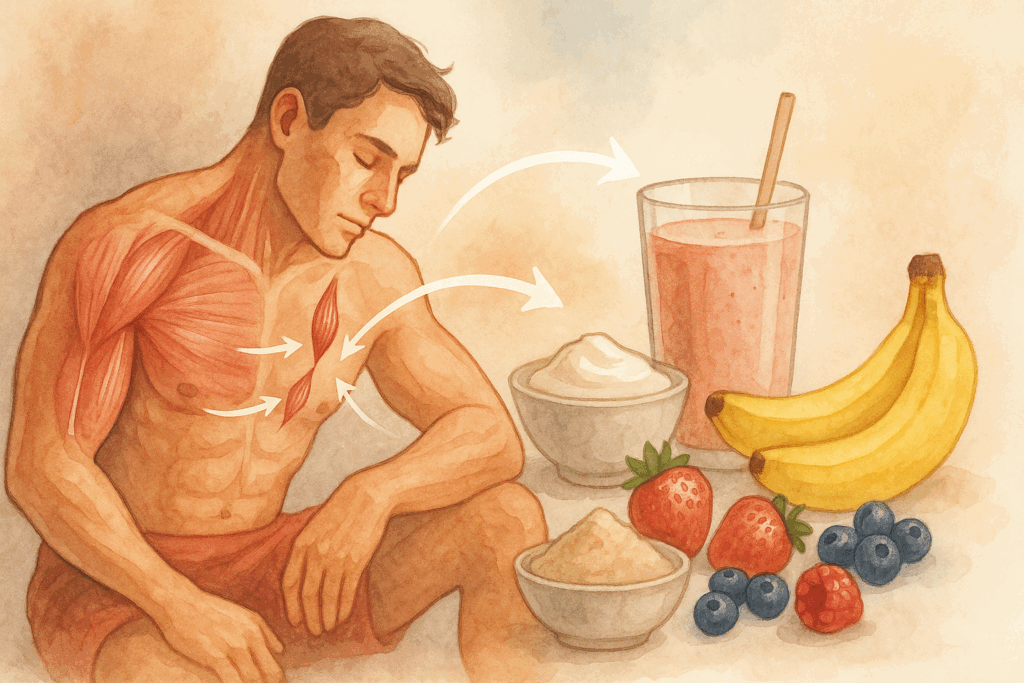
The Science Behind High-Protein Smoothies and Their Impact on Health
Understanding the physiological role of protein in the body underscores the importance of integrating it strategically through avenues such as healthy shakes and smoothies. Protein is critical for building and repairing tissues, synthesizing enzymes and hormones, and maintaining muscle mass, especially as we age. It also plays a role in immune response, metabolic regulation, and neurological function. For those who engage in resistance training or endurance sports, adequate protein intake is essential for performance and recovery. Healthy smoothies, when formulated with high-quality protein sources, offer a convenient and effective method for achieving these outcomes.
One of the unique advantages of consuming protein in liquid form is its rapid digestibility. Unlike solid meals that may take longer to break down, smoothies deliver nutrients to the bloodstream more quickly. This makes them particularly useful as post-workout recovery meals, where timing is key for muscle protein synthesis. Research has shown that consuming 20 to 30 grams of high-quality protein shortly after exercise can significantly improve muscle repair and growth. Smoothies make it easy to hit that target, especially when they include ingredients like whey protein, Greek yogurt, pea protein, or collagen peptides.
Additionally, smoothies that are high in protein often lead to improved satiety. This can reduce overall calorie consumption throughout the day by minimizing the urge to snack between meals. For individuals on weight management plans or those trying to build lean muscle, this benefit cannot be overstated. The inclusion of fiber-rich ingredients such as chia seeds, flaxseeds, oats, or leafy greens further enhances this satiety effect, while also promoting gut health and stable blood glucose levels. When combined, these attributes make healthy smoothies a scientifically sound choice for anyone aiming to improve their overall diet quality.
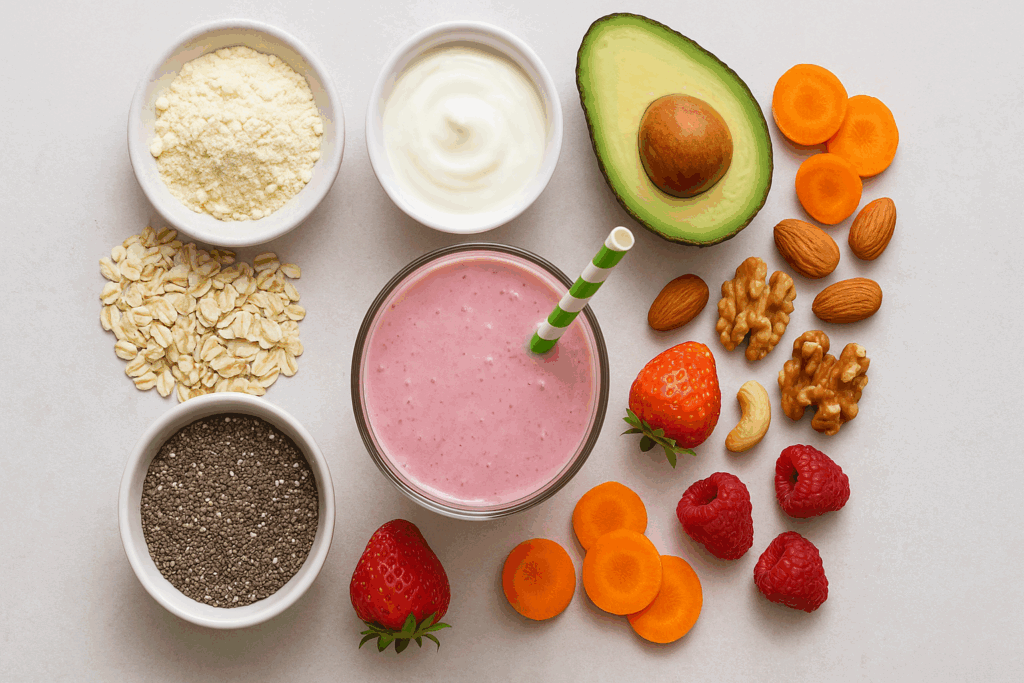
What Makes a Smoothie Truly “Healthy”? A Nutritional Breakdown
The label “healthy” can be deceptively broad, especially when applied to smoothies. Not all smoothies are created equal. Some are little more than fruit juices blended with sugar-laden yogurt or sorbet, delivering a calorie bomb with minimal nutritional payoff. To qualify as a truly healthy smoothie, especially within the context of high-protein diets, several nutritional criteria must be met. First and foremost, the protein content should be substantial—ideally 20 grams or more per serving. This ensures that the smoothie serves its intended role in supporting muscle function and satiety.
A healthy smoothie should also contain a balanced macronutrient profile. While protein takes center stage, the inclusion of healthy fats from sources like avocado, nut butter, or seeds enhances both nutrient absorption and satisfaction. Carbohydrates, preferably from whole fruits, vegetables, and grains, provide energy and essential vitamins. It’s important to avoid added sugars and instead rely on the natural sweetness of ingredients like banana, dates, or berries. Additionally, incorporating fiber-rich components not only aids digestion but also stabilizes the release of energy, preventing blood sugar spikes.
Micronutrient diversity is another hallmark of a healthy smoothie. Ingredients such as spinach, kale, cacao, turmeric, or spirulina offer a range of vitamins, minerals, and antioxidants that support cellular health and inflammation control. Liquids used should also be chosen with care—opt for unsweetened plant milks, low-fat dairy, or even green tea over fruit juices or flavored yogurts. By adhering to these principles, you can craft healthy smoothies that are not only protein-rich but also holistically nourishing and aligned with the goals of a balanced diet.

Best Times to Enjoy Healthy Smoothies for Maximum Effect
Timing plays a significant role in how effectively your body utilizes the nutrients delivered through smoothies. One of the most popular times to consume a high-protein smoothie is immediately after exercise. During this window, often referred to as the “anabolic window,” muscles are particularly receptive to nutrient intake. Providing the body with a mix of protein and carbohydrates can significantly enhance recovery, reduce muscle soreness, and stimulate muscle growth. Including easily digestible ingredients and fast-absorbing protein sources like whey or collagen ensures optimal uptake.
However, smoothies also make for an excellent breakfast option, particularly for individuals who struggle with morning appetite or time constraints. A well-formulated morning smoothie can jumpstart metabolism, stabilize blood sugar levels, and set the tone for healthier eating choices throughout the day. Ingredients like oats, berries, nut butter, and protein powder create a balanced morning meal that is both energizing and satiating. The portability of smoothies also allows for stress-free nourishment during commutes or busy mornings.
For those focused on weight management or intermittent fasting, healthy shakes can serve as an ideal meal replacement or fasting-breaker. In this context, smoothies should be designed with a higher fat content and moderate protein to prolong satiety. Evening smoothies, while less common, can be beneficial for those looking to curb late-night cravings or support overnight muscle repair. Including calming ingredients like banana, almond milk, and casein protein can promote restful sleep while delivering essential nutrients.
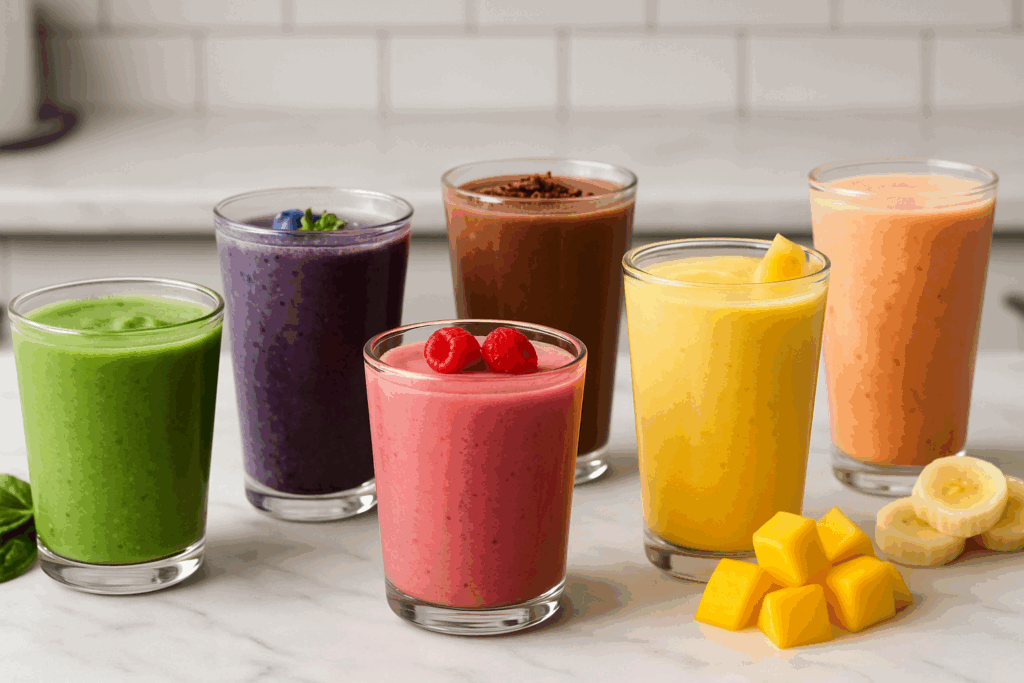
25 High-Protein Smoothie Recipes to Transform Your Nutrition
Creating a roster of go-to smoothie recipes can simplify your dietary routine and reduce decision fatigue. Below are 25 carefully curated recipes, each offering a unique flavor profile and nutritional focus while ensuring high protein content. These healthy smoothies range from plant-based blends to dairy-rich classics, offering something for every taste and dietary preference. Each one includes at least 20 grams of protein per serving and can be customized to suit your goals.
Chocolate Peanut Butter Muscle Builder
Blend unsweetened almond milk, chocolate whey protein, banana, peanut butter, cocoa powder, and a dash of cinnamon. This smoothie is a post-workout favorite due to its rich protein and energy-replenishing carbohydrate content.
Green Protein Detox
Combine spinach, kale, cucumber, green apple, unflavored protein powder, and chia seeds. Perfect for those seeking a clean, detoxifying option without sacrificing protein.
Berry Almond Blast
Use mixed berries, almond butter, Greek yogurt, and vanilla protein powder. This option is rich in antioxidants and ideal for boosting immunity.
Mango Coconut Power Fuel
Mix mango, coconut milk, plant-based protein, shredded coconut, and flaxseed. A tropical treat that offers protein and healthy fats in every sip.
Avocado Mint Recovery
Blend avocado, mint leaves, pea protein, frozen banana, and oat milk. This smoothie supports post-workout recovery with a creamy, refreshing twist.
Pumpkin Spice Protein Shake
Combine canned pumpkin, vanilla protein, almond milk, cinnamon, nutmeg, and oats. Ideal for fall mornings or when craving dessert-like flavors.
Cherry Cacao Endurance Boost
Use tart cherries, cacao nibs, chocolate protein, almond milk, and Greek yogurt. Tart cherries aid in inflammation control, making this a recovery favorite.
Strawberry Oat Smoothie
Mix strawberries, rolled oats, whey protein, almond milk, and a touch of vanilla. Excellent for sustained energy throughout the morning.
Blueberry Hemp Brain Booster
Combine blueberries, hemp seeds, banana, spinach, and protein powder. Rich in omega-3s and antioxidants for cognitive support.
Spirulina Sunrise Shake
Blend orange segments, spirulina, vanilla protein, pineapple, and coconut water. An energizing, nutrient-dense way to start your day.
Mocha Morning Builder
Use brewed coffee, chocolate protein, almond butter, banana, and oat milk. Ideal for caffeine lovers who want protein with their morning buzz.
Cinnamon Roll Smoothie
Mix Greek yogurt, vanilla protein, almond milk, cinnamon, oats, and dates. A breakfast-inspired option with rich flavor and satisfying protein.
Peach Cream Recovery Smoothie
Blend fresh or frozen peaches, vanilla whey, cottage cheese, and almond milk. Cottage cheese adds casein for slow-release protein.
Matcha Metabolism Booster
Combine matcha powder, unsweetened almond milk, banana, vanilla protein, and chia seeds. A great option for mental clarity and fat metabolism.
Zucchini Protein Shake
Use steamed zucchini, banana, vanilla protein, cinnamon, and oat milk. A surprising ingredient that adds creaminess and fiber.
Carrot Cake Smoothie
Mix carrots, vanilla protein, cinnamon, ginger, almond butter, and almond milk. A dessert-inspired blend with nutritional integrity.
Beet Berry Vitality Blend
Combine beets, mixed berries, Greek yogurt, and unflavored protein. Beets support nitric oxide production for vascular health.
Chocolate Cherry Sleep Support
Blend tart cherries, chocolate protein, almond milk, banana, and oats. A relaxing evening shake that also satisfies dessert cravings.
Coconut Vanilla Super Shake
Use coconut milk, vanilla protein, chia seeds, banana, and Greek yogurt. A creamy, decadent yet clean blend with balanced macros.
Almond Joy Protein Shake
Combine almonds, chocolate protein, shredded coconut, almond milk, and cocoa. A candy bar-inspired shake with no guilt.
Pineapple Turmeric Anti-Inflammatory Shake
Mix pineapple, turmeric, black pepper, vanilla protein, and coconut water. Great for joint support and inflammation control.
Apple Pie Smoothie
Use apple slices, oats, cinnamon, vanilla protein, and almond milk. A fiber-rich shake with nostalgic flavors.
Cucumber Melon Refresher
Combine cucumber, honeydew melon, mint, unflavored protein, and lime juice. Hydrating and light, perfect for hot days.
Banana Date Energy Shake
Blend banana, dates, peanut butter, whey protein, and oat milk. A natural energy booster for pre-workout fueling.
Chia Cacao Power Smoothie
Use cacao powder, chia seeds, vanilla protein, almond milk, and frozen banana. A satiating, antioxidant-rich blend that curbs sweet cravings.
How to Customize Healthy Smoothies for Your Unique Goals
One of the greatest strengths of high-protein smoothies is their customizability. Whether your primary goal is weight loss, muscle gain, improved digestion, or enhanced cognitive function, the components of your smoothie can be tailored accordingly. For muscle growth, emphasize complete proteins such as whey, casein, or soy, and pair them with moderate carbohydrates like oats or bananas to facilitate glycogen replenishment. Adding creatine or collagen peptides may further support performance and recovery.
If fat loss is your target, consider using lower-calorie bases like almond milk or water and incorporate high-fiber ingredients like chia seeds, leafy greens, or flaxmeal. Keeping the smoothie lower in sugar by avoiding high-glycemic fruits like mango or pineapple can support insulin sensitivity. For digestive health, add kefir, yogurt with probiotics, or prebiotic-rich foods like green banana and chicory root fiber. These additions can promote gut flora balance, which in turn influences everything from mood to metabolism.
Cognitive performance can be supported with ingredients such as blueberries, matcha, MCT oil, and spinach. These deliver neuroprotective antioxidants, healthy fats, and micronutrients that improve brain function. Meanwhile, for those managing blood sugar or metabolic conditions, combining healthy smoothies with protein and fat while avoiding added sugars helps ensure a gentle glycemic response. Ultimately, a smoothie’s effectiveness lies in its alignment with your personal goals, which can be fine-tuned through thoughtful ingredient selection.
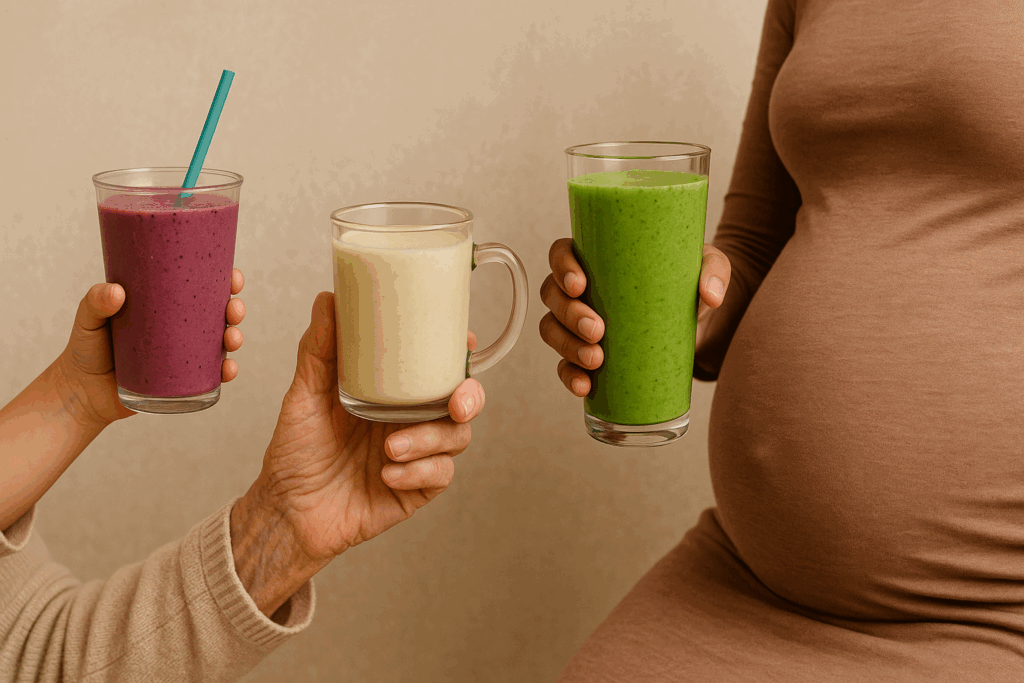
Customizing Healthy Smoothies for Children, Seniors, and Special Populations
High-protein smoothies can be adapted for different age groups and health conditions with thoughtful ingredient choices. For children, smoothies should focus on growth-supportive nutrients like calcium, iron, and healthy fats. A blend of full-fat yogurt, banana, berries, and almond butter can serve as a balanced and kid-friendly option. Sweetened naturally with dates or honey, these smoothies are both nutritious and palatable for young taste buds.
For seniors, the emphasis might be on protein density, easy digestion, and bone health. Ingredients like collagen, Greek yogurt, fortified plant milk, and anti-inflammatory spices such as turmeric support aging physiology. Texture and digestibility are crucial for this group, so blending until silky smooth is essential. For individuals managing health conditions like diabetes or cardiovascular disease, low-sugar, high-fiber, and low-sodium formulations are preferred. These may include leafy greens, berries, unsweetened almond milk, and plant-based protein.
Pregnant and breastfeeding individuals may benefit from smoothies rich in folate, calcium, protein, and omega-3s. Including ingredients such as chia seeds, spinach, citrus fruits, and hemp seeds can help meet elevated nutritional needs. Ultimately, customization allows healthy smoothies to become a safe and effective nutritional strategy for people across the lifespan and across varying health circumstances.

The Environmental and Ethical Dimensions of Healthy Shakes
In the broader context of nutrition, the sustainability and ethics of food choices are increasingly relevant. Healthy smoothies offer an environmentally friendly platform when crafted with sustainability in mind. Choosing local, organic produce minimizes the carbon footprint of your shake, while opting for plant-based proteins reduces reliance on resource-intensive animal agriculture. Using reusable straws, glass containers, and composting organic waste contributes to a zero-waste smoothie routine.
From an ethical perspective, selecting fair-trade ingredients like cacao, coffee, or tropical fruits ensures that farmers are compensated fairly and treated humanely. Supporting small-scale producers of nuts, seeds, and grains can also foster global equity and contribute to economic resilience in developing regions. In this way, your daily smoothie can serve not only your body but also the planet and its people, reinforcing the interconnectedness of personal and planetary health.
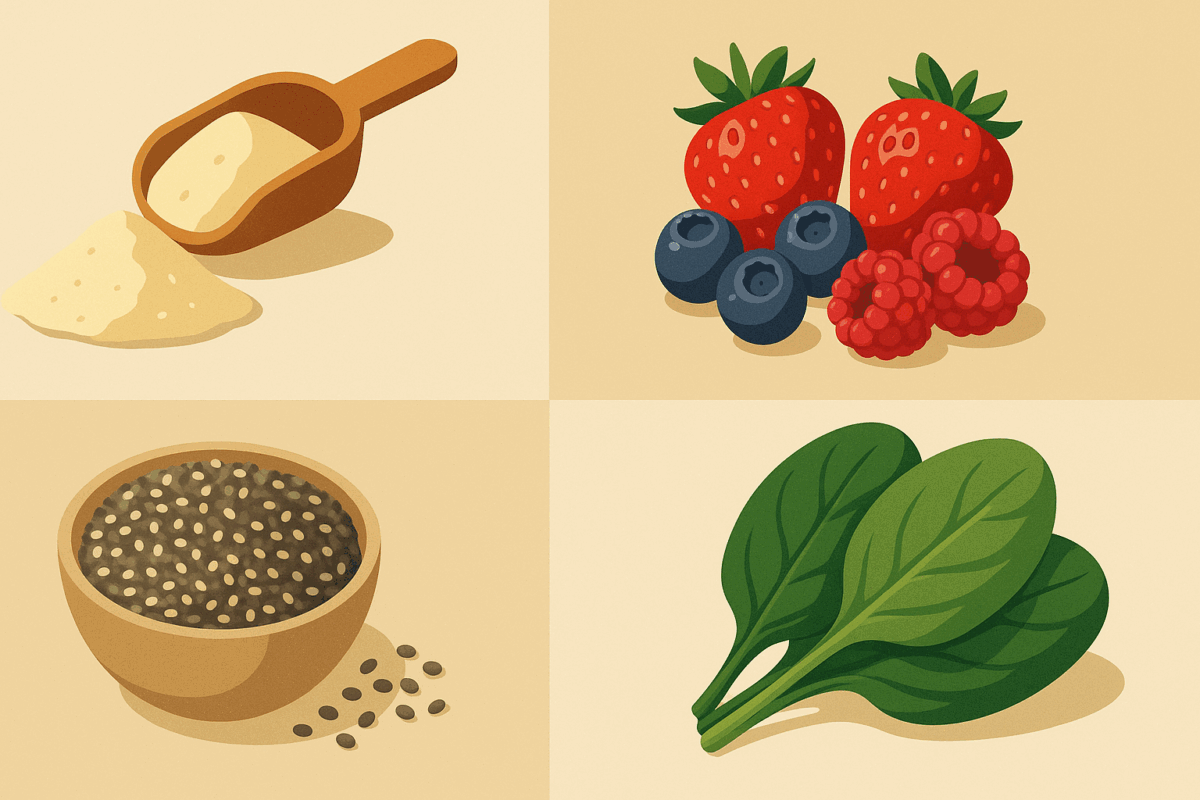
Essential Ingredients That Make Healthy Shakes Genuinely Nutritious
Crafting a genuinely healthy shake involves more than simply adding protein powder to a blender. Every ingredient should serve a functional purpose. High-quality protein sources form the foundation, but equally important are the synergistic components that enhance absorption, digestion, and bioavailability. For instance, healthy fats such as avocado, flaxseed, or MCT oil help absorb fat-soluble vitamins like A, D, E, and K. These fats also play a role in hormone production and cellular function.
Fiber is another critical element. Found in oats, berries, chia seeds, and leafy greens, fiber supports digestive health, aids in cholesterol management, and provides long-lasting fullness. Liquids used as a base should be nutrient-dense and low in sugar. Unsweetened almond milk, oat milk, kefir, and coconut water are excellent choices. Avoid fruit juices or flavored yogurts, as they often contribute unnecessary sugars.
Functional boosters can take your healthy shakes to the next level. These include adaptogens like ashwagandha, anti-inflammatories like turmeric and ginger, and micronutrient-rich additions like spirulina and cacao. Incorporating such ingredients not only boosts the health quotient but can also enhance taste and variety. Finally, the use of whole fruits and vegetables ensures a diverse intake of vitamins, minerals, and antioxidants that contribute to overall wellness. Together, these components transform a basic shake into a powerhouse of nutritional support.
Frequently Asked Questions: Expert Insights on Healthy Smoothies and High-Protein Nutrition
1. How do healthy smoothies support long-term metabolic health beyond muscle building?
While most people associate high-protein smoothies with muscle repair or fitness recovery, their impact on long-term metabolic health is just as compelling. Regularly consuming healthy smoothies that are balanced with protein, fiber, and healthy fats can help stabilize blood sugar levels, which reduces the risk of insulin resistance and type 2 diabetes over time. Including ingredients such as cinnamon, flaxseeds, and low-glycemic fruits like berries can further enhance these effects by improving glucose metabolism. Additionally, high-protein smoothies help maintain lean body mass during weight loss, which is critical for preserving a higher resting metabolic rate. Over months or years, these metabolic benefits compound, making well-structured healthy shakes a valuable tool for sustained health and disease prevention.
2. Can healthy smoothies improve focus and productivity during the workday?
Absolutely—when formulated with brain-supportive nutrients, healthy smoothies can have a noticeable effect on mental clarity, concentration, and cognitive stamina. Ingredients rich in omega-3 fatty acids, such as chia seeds and walnuts, support neuronal membrane integrity and neurotransmitter function. Berries contribute polyphenols that enhance memory and protect against cognitive decline, while matcha or green tea can provide a smooth source of caffeine combined with calming L-theanine to avoid the jitteriness of coffee. Adding protein also prevents energy crashes by slowing digestion and maintaining blood glucose stability throughout the day. When consumed during breakfast or mid-morning, these high-performance healthy shakes can promote focus and optimize decision-making in high-pressure work environments.
3. What role do healthy shakes play in gut health and microbiome balance?
Healthy shakes can significantly support digestive health when formulated with prebiotic and probiotic components. Prebiotic ingredients like green banana, oats, or Jerusalem artichoke feed beneficial gut bacteria, helping maintain a balanced microbiome. Meanwhile, adding fermented foods like kefir, cultured yogurt, or kombucha to a smoothie introduces live probiotics that enhance gut flora diversity. This microbial diversity is linked to improved digestion, stronger immunity, and even better mood regulation due to the gut-brain axis. Protein sources that are easy to digest—such as collagen peptides or rice protein—minimize gastrointestinal distress, making healthy smoothies a soothing option for those with irritable bowel issues. In this context, smoothies act not just as a meal replacement but as a daily tool for nurturing a healthier gut ecosystem.
4. Are there strategies to extend the shelf life of pre-made healthy smoothies?
Yes, with careful preparation and storage, healthy smoothies can retain their flavor and nutritional integrity for up to 48 hours. Using frozen fruits and vegetables slows oxidation, while lemon juice or other citrus elements help preserve color and vitamin content by lowering pH. Airtight, glass containers are preferred over plastic, as they limit chemical leaching and prevent off-flavors. For added freshness, consider storing ingredients separately in pre-portioned bags and blending just before consumption if possible. Alternatively, vacuum-sealing blended healthy shakes can further protect against air exposure, making them ideal for busy individuals who need to prep meals in advance without sacrificing nutrition.
5. How can healthy smoothies be adapted for low-carb or ketogenic diets?
While traditional smoothies often rely on fruit for sweetness and texture, low-carb adaptations are entirely possible without compromising flavor or nutrition. Healthy smoothies suitable for ketogenic diets typically emphasize high-fat and moderate-protein ingredients, such as avocado, coconut cream, almond butter, and unsweetened nut milk. To add sweetness without spiking blood sugar, natural low-glycemic sweeteners like stevia, monk fruit, or erythritol can be used. Non-starchy vegetables like spinach, cucumber, and zucchini provide volume and fiber, while protein can be sourced from collagen or bone broth powder for added benefits. These keto-friendly healthy shakes offer sustained energy, mental clarity, and hormonal support while helping the body remain in a fat-burning state.
6. What’s the role of temperature and texture in the psychological enjoyment of healthy smoothies?
The sensory experience of drinking healthy smoothies plays a major role in habit formation and satisfaction. Texture can influence fullness perception—thicker shakes tend to be more satiating and may signal to the brain that a larger meal has been consumed. Using frozen ingredients can also enhance creaminess without the need for added dairy, creating a dessert-like indulgence that supports compliance in healthy eating. The cold temperature itself can have mood-enhancing effects, especially in the morning, acting as a gentle stimulant. Conversely, for individuals with sensitive digestion or in colder climates, room-temperature shakes using fresh (not frozen) ingredients may be easier to tolerate. Tailoring these sensory elements ensures that healthy shakes remain a consistent and pleasurable part of your diet.
7. How are healthy smoothies being used in elite sports nutrition and recovery protocols?
In professional sports, healthy smoothies are now commonly used in customized recovery plans tailored to the athlete’s sport, position, and metabolic needs. They allow precise control over macronutrient timing and ratios, such as delivering a 3:1 carbohydrate-to-protein ratio immediately post-training to maximize glycogen replenishment and muscle repair. Additives like creatine, beta-alanine, and tart cherry concentrate can be included to enhance endurance, reduce inflammation, or speed up muscle recovery. Elite athletes may rotate different smoothie formulas based on training phases—higher-carb versions for endurance days and high-fat, anti-inflammatory blends during deload or recovery periods. The use of portable, pre-blended healthy shakes also ensures athletes meet their nutritional targets when traveling, making them a foundational tool in performance nutrition.
8. What are some innovative, culturally inspired ingredients to explore in healthy smoothies?
Global cuisine offers a rich array of ingredients that can elevate both the flavor and functionality of healthy smoothies. In Japanese-inspired blends, ingredients like matcha, yuzu, and black sesame add antioxidants and unique taste dimensions. Indian-inspired smoothies might include cardamom, turmeric, mango, and ghee, which offer digestive and anti-inflammatory properties. From Latin America, consider incorporating lucuma, maca root, or acai berries—each rich in polyphenols and adaptogens. African superfoods like baobab powder or moringa leaf provide vitamin C and iron, supporting energy and immunity. These culturally diverse additions not only diversify your nutrient intake but also introduce novel taste profiles, keeping healthy shakes interesting and expanding their health benefits.
9. Why are healthy smoothies particularly effective for appetite regulation and emotional eating?
Healthy smoothies provide a unique combination of satiety signals, nutrient density, and flavor satisfaction that can significantly reduce emotional and mindless eating. The blend of protein, fiber, and healthy fat slows gastric emptying and sustains fullness, making it easier to resist cravings triggered by stress or boredom. Smoothies also serve as a structured meal, which helps prevent the chaotic eating patterns often linked with emotional eating cycles. The act of preparing and drinking a smoothie can serve as a mindfulness ritual, shifting attention away from impulsive snacking behaviors. When sweetened naturally with fruits or spices like cinnamon and vanilla, healthy shakes can also satisfy dessert cravings without the post-sugar crash, making them a strategic emotional wellness tool.
10. How are healthy smoothies likely to evolve with future advances in food tech and personalization?
The future of healthy smoothies is poised for exciting innovation through personalized nutrition, biotechnology, and smart kitchen technologies. Wearable health trackers and microbiome tests could soon integrate with apps that generate real-time smoothie recipes based on your biomarkers, activity levels, and nutrient deficiencies. Ingredient enhancements like lab-cultured collagen, precision-fermented protein powders, and nano-encapsulated vitamins may offer superior absorption and targeted health benefits. AI-powered blenders could optimize nutrient retention based on ingredient density and desired outcomes—such as boosting cognition or enhancing recovery. As sustainability becomes more urgent, protein sources from algae, duckweed, or recycled food waste may become mainstream in healthy shakes. These advancements will redefine the role of smoothies from convenient meal options to hyper-personalized wellness interventions.
Conclusion : Making Healthy Smoothies a Daily Habit
Creating and maintaining the habit of consuming healthy smoothies daily can yield significant benefits across energy, mood, body composition, and long-term health. To make the habit sustainable, it’s important to plan ahead. Pre-portioning ingredients in freezer-safe bags, investing in a high-quality blender, and maintaining a variety of ingredients on hand can streamline the process. Setting a routine, whether it’s a morning ritual or a post-workout standard, ensures consistency and builds positive momentum.
Rotating recipes is equally crucial to prevent palate fatigue and ensure a broad spectrum of nutrients. Tracking your macros and energy levels in relation to different smoothie compositions can also help you identify which blends work best for your body. For individuals managing specific health concerns, consulting with a registered dietitian or nutritionist can fine-tune your approach and provide personalized recommendations.
Incorporating healthy smoothies into your diet isn’t just a trend—it’s a scientifically validated, nutrient-dense, and versatile method to optimize daily nutrition. By blending expert-backed strategies with flavorful, functional ingredients, you can elevate your dietary practices and move closer to your wellness goals with every sip. From weight management and muscle gain to mental clarity and immune support, the potential benefits of these delicious beverages are far-reaching. Let your blender become the gateway to better health, one expert-approved recipe at a time.


